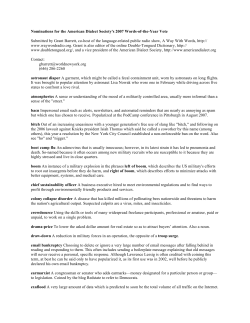
SECURITY AGREEMENT & GUIDE Included: Overview
SECURITY AGREEMENT & GUIDE Included: Overview Dos and Don’ts Checklist Security Agreement Instructions Sample Security Agreement (0109) © LEGALZOOM.COM, INC. 2008 1. Overview Successful businesses are built on big ideas and long-range goals, but without sufficient capital, those dreams may never be realized. Limited start-up funds can stop a company in its tracks: business owners often underestimate the amount of money they will need to keep their organization running, and close their doors before they’ve had a chance to get a market foothold. Many owners also expect their companies to turn a profit on Day 1, failing to consider expenses, competition, and the time it takes to build a customer base. Whatever the reasons, individuals and companies often must borrow money to keep their businesses afloat. They can turn either to large financial institutions or to friends, colleagues, and relatives for support. The enclosed documents may prove more useful for a company looking to borrow money from less formal sources, since commercial lenders may be reluctant to loan money to businesses without defined income streams and, moreover, will usually require businesses to use their standardized forms. Nonetheless, the sample form and instructions that follow may provide a good starting point for any person or business seeking information about loan terms and deal structures. Borrowers who agree to sign secured notes may find loans more readily available to them. Lenders know that if a default occurs, they can sell the property used as collateral under the secured note. This protection may, in turn, make a borrower more comfortable with the loan arrangement. Nobody wants to default on a loan or force others to absorb losses on their behalf. When a security interest is granted, you can be sure you’re not leaving lenders – who may be colleagues or other individuals close to you – out in the cold. A security agreement provides further assurance. It explains the specifics of how collateral can be claimed by the lender and what the borrower must do to protect the lender’s interest in that property. This package contains everything you’ll need to customize and complete your security agreement. A written agreement minimizes confusion, misunderstanding, and error, and clearly sets forth the parties’ expectations and fulfillment obligations. In every way, this promotes a successful and profitable business arrangement. 2. Dos & Don’ts Checklist Before sitting down to sign, decide exactly what your goals are for the security agreement. How much property will be needed to secure the loan? What types of property? If there is a conflict between documents, which document will take precedence? A good agreement is one that captures the intentions of the parties accurately. Take a moment to clarify the terms and conditions of your agreement before memorializing them in written form. Allow each party to spend some time reviewing the security agreement. This will reduce the likelihood, or at least the efficacy, of claims that a party did not understand any terms or know what their obligations were under the document. Both parties should review the agreement carefully to ensure that all relevant deal points have been included. Do not assume that certain expectations or terms are agreed to if they are not stated expressly on the document. SECURITY AGREEMENT © LEGALZOOM.COM, INC. 2008 1 Security agreements are generally used to supplement a secured promissory note. The note is the borrower’s actual promise to repay the money it received. The enclosed security agreement assumes the existence of a secured promissory note, but that agreement is not included with this package. A security interest in property can (and should) be memorialized with a financing statement (more specifically, a document called a UCC financing statement). Once a financing statement is completed and filed with the correct governmental authority, the lender’s interest in the property is considered “perfected.” This means that if future lenders also seek a security interest in the same asset, the lender with the perfected interest would have top priority and could take the property for itself after a default. Sign two copies of the agreement, one for you and one for the other party. Depending on the nature of its terms, you may decide to have your agreement witnessed or notarized. This will limit later challenges to the validity of a party’s signature. If your agreement is complicated, do not use the enclosed form. Contact an attorney to help you draft a document that will meet your specific needs. 3. Security Agreement Instructions The following provision-by-provision instructions will help you understand the terms of your security agreement. The numbers below (e.g., Section 1, Section 2, etc.) correspond to the provisions in the agreement. Please review the document in its entirety before starting the step-by-step process. • Introduction. Identifies the document as a security agreement. Write in the date on which the agreement is signed. This should be the same date that the secured note is signed and made effective. Identify the parties and, if applicable, what type of organization(s) they are. Note that one party is called the “Lender” and the other the “Borrower.” As you probably guessed, the Lender is the party that loaned the money under the note and the Borrower is the party that is securing its promise to pay with this agreement. • Section 1: Indebtedness. Describes exactly what is being secured by the agreement. Although the paragraph is quite lengthy, it’s meant simply to state that the agreement is meant to make sure that the borrower will repay the loan that the Lender provided. • Section 2: Reaffirmation of Loan. The Borrower’s reiteration of its obligations under the loan. • Section 3: Secured Property. Lists the property that Borrower is using as collateral for the loan. • Section 4: Grant of Security Interest in Secured Property. Ensures the Borrower’s repayment by providing the security interest in certain property as collateral. • Section 5: Borrower’s Representations and Warranties. The Borrower’s promises that it will protect the property security of its loan. SECURITY AGREEMENT © LEGALZOOM.COM, INC. 2008 2 • Section 6: Events of Default. Lists the situations in which the Lender can declare that a default has occurred, and can seek the remedies listed in Section 7. These events include defaults in payment, loss or damage to collateral property, bankruptcy filings, or entries into receivership. • Section 7: Remedies for Events of Default. A description of the actions the Lender can take if one of the defaults listed in Section 6 occurs. These include demanding the entire amount of the loan and selling the collateral to repay that loan. • Section 8: Termination. Provides that the security agreement will terminate when the Borrower has paid off its loan. • Section 9: Successors and Assigns. States that the parties’ rights and obligations will be passed on to heirs or, in the case of companies, to successor organizations. • Section 10: Notice. Lists the addresses to which all official or legal correspondence should be delivered. Write in a mailing address for both the Borrower and the Lender. • Section 11: Governing Law. Allows the parties to choose the state and county laws that will be used to interpret the agreement. Note that this is not a venue provision: the included language will not impact where a potential claim can be brought. Please write the applicable state and county in the blanks provided. • Section 12: Entire Agreement. The parties’ agreement that the agreement they’re signing, together with any supporting agreements, is “the agreement” about the issues involved. Unfortunately, the inclusion of this provision will not prevent a party from arguing that other enforceable promises exist, but it will provide you some protection from these claims. • Section 13: No Implied Waiver. Explains that even if the Lender ignores or allows the Borrower to break an obligation under the agreement, it does not mean the Lender waives future rights to require the Borrower to fulfill those obligations. • Section 14: Inconsistencies. When more than one agreement is signed, there is a risk that the provisions of one may contradict the provisions of the other. This risk increases when even more agreements are signed. This provision lets you designate which agreement will control if there are conflicts between agreements. • Section 15: Severability. Protects the terms of the agreement as a whole, even if one part is later invalidated. • Section 16: Counterparts/Electronic Signatures. The title of this provision sounds complicated, but it is simple to explain: it says that even if the parties sign the rescission in different locations, or use electronic devices to transmit signatures (e.g., fax machines or computers), all of the separate pieces will be considered part of the same document. In a modern world where signing parties are often not in the same city - much less the same room - this provision ensures that business can be transacted efficiently, without sacrificing the validity of the rescission. • Section 17: Headings. Notes that the headings at the beginning of each section are meant to organize the document, and should not be considered operational parts of the agreement. • Exhibit A: Note. Attach a copy of the promissory note to the Security Agreement as Exhibit A. SECURITY AGREEMENT © LEGALZOOM.COM, INC. 2008 3 DISCLAIMER LegalZoom is not a law firm. The information contained in the packet is general legal information and should not be construed as legal advice to be applied to any specific factual situation. The use of the materials in this packet does not create or constitute an attorney-client relationship between the user of this form and LegalZoom, its employees or any other person associated with LegalZoom. Because the law differs in each legal jurisdiction and may be interpreted or applied differently depending on your location or situation, you should not rely upon the materials provided in this packet without first consulting an attorney with respect to your specific situation. The materials in this packet are provided "As-Is," without warranty or condition of any kind whatsoever. LegalZoom does not warrant the materials' quality, accuracy, timeliness, completeness, merchantability or fitness for use or purpose. To the maximum extent provided by law, LegalZoom, it agents and officers shall not be liable for any damages whatsoever (including compensatory, special, direct, incidental, indirect, consequential, punitive or any other damages) arising out of the use or the inability to use the materials provided in this packet. SECURITY AGREEMENT © LEGALZOOM.COM, INC. 2008 4 Form Sample SECURITY AGREEMENT © LEGALZOOM.COM, INC. 2008 5
© Copyright 2025





















